Nikon D2HNikon introduces an 8 frame/second speed demon, with WiFi connectivity and an amazing new flash system to boot!<<Test Results: Color :(Previous) | (Next): Conclusion>> Page 15:Test Results: ResolutionReview First Posted: 12/18/2003 |
Test Results: Resolution and Sharpness
As I mentioned earlier, at the initial press briefing for the D2H, Nikon seemed to make the claim that the LBCAST sensor technology used in the D2H would lead to sharper images than those from cameras using conventional CCDs. To examine this, I shot the comparison images below with the D2H and EOS-1D, under as nearly identical conditions as possible. I used each manufacturer's ~100mm macro lens for the shots, as these fixed focal length lenses are among the sharpest either maker produces. (On the D2H, I used the Micro-Nikkor 105mm f/2.8, while I used the Canon 100mm f/2.8 EF lens on the EOS-1D.) The slight difference in focal length meant that I had to shift position slightly on the outdoor shots to keep the subject at the same scale between the two cameras. Other than that, all shooting parameters were identical.
ISO-12233 Resolution Target.
The images below were cropped from best-quality JPEGs from each camera. To avoid any visual bias due to differences in brightness, I've adjusted each image slightly in Photoshop, using the Levels control, to insure that the white values were identical across all samples. (As always clicking on the images will take you to the original files for each sample.) Two sets of results are shown for both the D2H and EOS-1D. The first shows the results obtained using the cameras' default sharpening settings, the second shows the best results I could get, working from unsharpened camera images, and applying unsharp masking in Photoshop. The amounts of USM applied were matched to the characteristics of the images, to attempt to wring the maximum sharpness from each camera's images. In the case of the D2H, I found 240% at an 0.3 pixel radius produced the best-looking image with the fewest artifacts, while for the EOS-1D, the best settings were 180% and 0.3 pixels.
|
ISO-12233
Res Target Results |
||
| D2H | EOS-1D | |
| Camera Default Sharpening | ||
| No camera sharpening, then Photoshop unsharp masking. | ||
Overall, these results show that the D2H is able to resolve about 1,100 lines
of "strong detail" horizontally, and perhaps 1,000 vertically.
Performance is thus pretty equivalent between the D2H and the EOS-1D, at
least on an artificial, high-contrast subject like the ISO-12233 resolution
target. (I could possibly convince myself that the D2H has a slight edge
in these shots, but if it does, the difference is awfully subtle.) While
the 1D's default sharpening setting results in slightly softer images, the
ultimate resolving power of the two cameras appears very similar.
Resolution/Sharpness vs ISO
As I alluded to earlier when we were talking about the D2H's noise performance, cameras' noise-suppression algorithms work by throwing away high-frequency image content in areas where the program thinks there isn't any relevant subject detail present. The trick comes in setting the threshold for the noise suppression routine high enough to preserve important subject detail, without allowing too much noise through as well.
As ISO increases, so does image noise, with the result that camera manufacturers generally apply more aggressive noise-suppression at high ISOs. This can lead to a loss of subject detail in high-ISO shots. To determine whether this might be an issue with the D2H or not, I shot the series of images below at a range of ISOs from 200 to 3200, with both the D2H and EOS-1D. Here again, I shot the images with each manufacturer's ~100mm macro lens, both of which were stopped down to the same mid-range aperture (f/8 in this instance). These images were all captured with the cameras' default image-sharpening settings, and are cropped from minimum-compression JPEG files. (The full-res files are linked to the crops below, so you can access any of them by clicking on the images.)
|
Resolution
vs ISO |
||
| D2H | EOS-1D | |
| ISO 200 | 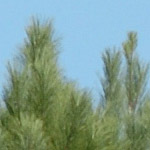 |
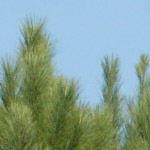 |
 |
 |
|
| ISO 400 | 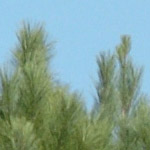 |
(The 1D shot at ISO 400 was slightly out of focus, so I chose to skip its samples here.) |
 |
||
| ISO 800 | 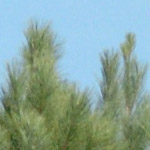 |
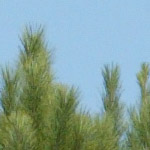 |
 |
 |
|
| ISO 1600 | 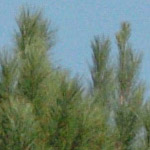 |
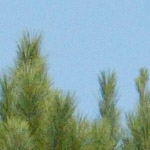 |
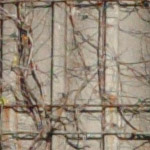 |
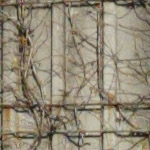 |
|
| ISO 3200 | 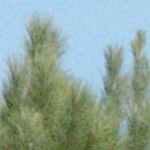 |
 |
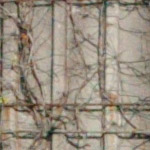 |
 |
|
From these shots, it seems that there's a little falloff in the D2H's sharpness at ISO levels starting right at 200, although the decrease is fairly slight until we get all the way out to ISO 3200. These image samples also seem to show a slight edge overall for the EOS-1D's rendering of fine detail, regardless of ISO.
D2H Image Sharpening
A valid question to ask in the above is how good a job the D2H's "auto" sharpening does, as compared to post-exposure tweaking in either Nikon Capture or Photoshop.
Other than the first shot shown (which displays the results of the D2H's default or "auto" sharpening in the camera), the images below were all processed from the same NEF file. All went through Nikon Capture 4.0 with the indicated sharpening setting applied. The Photoshop-sharpened sample was extracted from the NEF file with no sharpening applied, and then unsharp-masked with radius of 0.5 pixels and amount of 200%. (This last representing the combination of settings that seemed to produce the most crisp-looking image for this particular subject, with the least haloing or loss of fine detail.)
Overall, the D2H's internal "auto" sharpening does a pretty
good job, although it does coarsen fine detail somewhat. While it loses
a little detail in the process though, I have to admit that the default
in-camera sharpening looks sharper to my eye than does the carefully
tweaked and technically more "correct" sharpening I applied
in Photoshop.
Image-sharpening settings are obviously largely a matter of personal
preference, but the default processing of the D2H does seem to deliver
decent-looking results.
The Bottom Line for Resolution
The D2H seems to deliver appropriate resolution for its 4.1 megapixel sensor. Using the in-camera sharpening, detail is rendered a little more coarsely than it might be, but turning sharpening off and doing your sharpening in Photoshop provides resolution that's pretty equivalent with that of other top-performing four-megapixel models. (Good news, I'd say: It seems to me that Nikon has backed off just a hair on their anti-aliasing filter, with the result that there's a bit more detail, but still without any significant aliasing.) Resolution does diminish somewhat at higher ISO settings though, as the noise-suppression algorithms take their toll.
Other Performance Attributes
With the "big three" of Color, Resolution/Sharpness, and Image Noise out of the way, let's finish up with summaries of the other key performance parameters that I routinely comment on.
- Exposure Accuracy: The D2H did pretty well in
this area, generally requiring less exposure compensation than
I'm accustomed to seeing among the digicams I test. The one exception
to this was the Indoor Portrait tests, where the combination of
the very warm-toned light source and somewhat high-key subject
required a half to a third of a stop more exposure compensation
than I usually have to apply there. Overall though, the matrix
metering on the D2H was remarkably sure-footed.
- Low-Light Capability: As I noted earlier in my
discussion of the D2H's noise characteristics, Nikon's new LBCAST
sensor technology does indeed appear to be a breakthrough in the
area of dark-current noise. The D2H shot some of the cleanest long-exposure
images I've seen from any camera to date. Its autofocus system
also worked well at very low light levels, focusing reliably down
to about 1/10 foot-candle (about 1 lux) with an f/4 lens attached.
Overall, the D2H constitutes a superb choice for the low-light
shooter.
- Viewfinder Accuracy: I always appreciate really
accurate viewfinders on cameras, and have a hard time understanding
why even some high-end cameras stop short at 95% or so. I was thus
very pleased to see that the D2H has a true 100% viewfinder, that
very accurately displayed what would appear in the final image.
- Shutter Lag and Cycle Time: Are you kidding?
This baby is fast! In every respect, the D2H is an industry-leading
design, with ultra-fast shutter lag and cycle times, a huge buffer
memory, and very fast write speeds to memory cards, letting it
clear its buffer to be ready for the next series of shots unusually
quickly. (This is definitely a camera that you'll want to equip
with a good fast CF card.)
- Battery Life: Because it uses a proprietary power connector, I couldn't perform my unusual power tests on the D2H. From personal experience though, I can certainly attest to its exceptional battery life. On several separate occasions, I've shot more than 1000 frames with it, and still had more than half the battery capacity remaining. (And the "battery health" display in the menu system is a very nice touch too, so you'll know when its time to trade in your battery pack for a new one.) The battery pack lasts long enough that I'll make an exception to my usual recommendation of a second battery pack. Unless you're a pro shooting literally thousands of images at a time, there really isn't any need for an additional pack.
Reader Comments! --> Visit our discussion forum for the Nikon D2H!

Follow Imaging Resource: